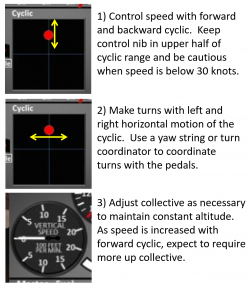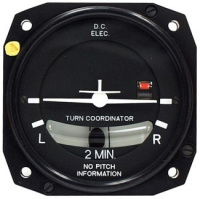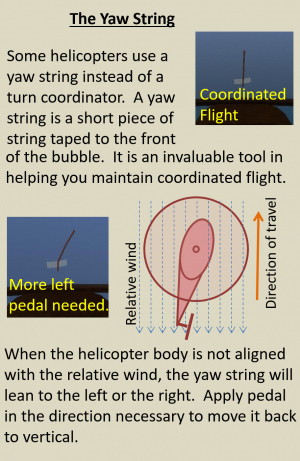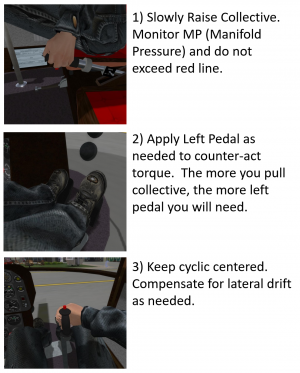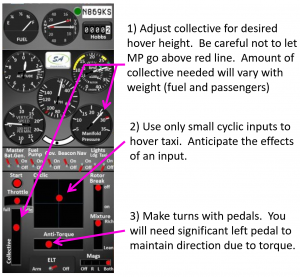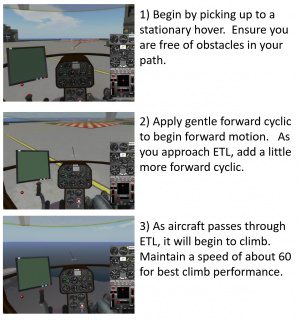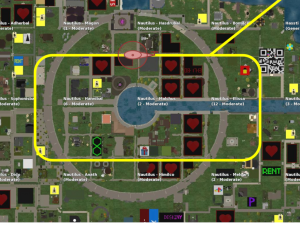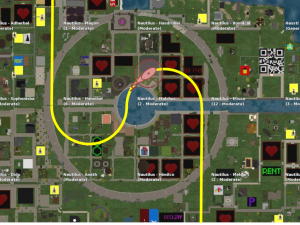SL Helicopter Flying Handbook/Basic Flight Maneuvers
SECTION 8. Basic Flight Maneuvers
1 Cruise Flight
There are four fundamentals of flight upon which all maneuvers are based: straight-and-level flight, turns, climbs and descents. The initial goal of the student pilot should be to master these four fundamentals and be able to perform them based on an accurate feel and understanding of how the helicopter will perform.
Some general guidelines are as follows:
- Make control inputs slowly and smoothly. Abrupt control movements risk exceeding an aircraft limitation and departing controlled flight.
- Anticipate the effect of environmental conditions. The helicopter will not react the same way, or require the same control inputs at high altitude compared to sea-level.
- Understand the limitations and flight characteristics of the helicopter you are flying:
- In left turns, there is increased torque, so more anti-torque (left pedal) will be required.
- In right turns, there is decreased torque, so less anti-torque (right pedal) will be required.
- Normal helicopter landings to a hover require increased helicopter power.
- Always leave a way out if a maneuver must be aborted for some reason.
Figure 1 shows the basic control positions that should be used in cruise flight. The cyclic should be forward of center, with airspeed controlled by moving cyclic forward or aft. Turns are made primarily with left/right cyclic. Finally, collective is adjusted to achieve a zero vertical speed.
1.1 Straight-and-Level Flight
In straight-and-level cruise flight, the goal should be to fly a constant heading at a constant speed without gaining or losing altitude. In addition, the aircraft should be horizontally level and well coordinated. Use collective to control altitude using the VSI (Vertical Speed Indicator) as reference. If a descent or climb is indicated, increase or decrease collective to maintain altitude. Airspeed is controlled with the forward and backwards cyclic. Move the cyclic forward to increase airspeed, and ease back on the cyclic to reduce airspeed. Meanwhile, heading control is maintained with left and right cyclic. Use left/right cyclic opposite to any drift either by reference to the heading indicator, or the horizon to keep the helicopter level and on course.
The pedals are used to maintain coordination. This is normally done with the turn coordinator (Figure 2), but some aircraft may use a yaw string Figure 3. Coordination using the turn coordinator is performed with reference to the black ball, usually at the bottom of the instrument. When the black ball is deflected to the inside of the turn (e.g., the ball is deflected right of center in a right turn), this is called a slip. When the black ball is deflected to the outside of the turn (e.g., the ball is deflected left of center in a right turn), this is called a skid. Pedal should be applied on the side to which the ball moves. Think "step on the ball".
Common Errors
- Failure to maintain coordinate flight
- Failure to maintain target airspeed
- Failure to hold a specific ground track
1.2 Turns
Turns should be made primarily with the cyclic, using the pedals to maintain coordination. Turns are made by deflecting a portion of the thrust vector toward the direction of turn. For this reason, it may be necessary to increase collective to maintain altitude in a turn. In a turn with a 60 degree bank, the amount of thrust needed to maintain altitude is twice that needed to maintain altitude in level flight. In normal operations turns should be limited to 30 degrees of bank. As in straight-and-level flight, the pilot should use the turn coordinator or yaw string to maintain coordination.
Common Errors
- Failure to maintain altitude and airspeed
- Using too little or not enough anti-torque pedal
1.3 Normal Climbs
To enter a climb at constant airspeed, the pilot should simultaneously increase collective and throttle, then adjust pedals as necessary to maintain coordination. Since an increase in collective will also increase the horizontal component of lift, the cyclic must also be moved aft slightly, or airspeed will increase. Remember that unlike in an airplane, the attitude of a helicopter does not change significantly in a climb vs. straight-and-level flight.
If the pilot wishes to climb with decreased airspeed, then a climb can be initiated with aft cyclic. This will reduce the horizontal component of total thrust and redirect it downward, thus resulting in a a climb.
To level off from a climb, gradually reduce the collective, and apply a small amount of forward cyclic to maintain airspeed. You should lead your level-off by approximately 10% of your climb rate. For example if climbing at 500 feet/min, begin your level-off 50 feet before your target altitude.
Common Errors
- Failure to maintain power for target airspeed
- Failure to adjust anti-torque as the power applied changes
- Leveling off too soon or too late
1.4 Normal Descents
To enter a descent at constant airspeed, the pilot should simultaneously decrease collective and throttle, then adjust pedals as necessary to maintain coordination. Since an decrease in collective will also decrease the horizontal component of lift, the cyclic must also be moved slightly forward, or airspeed will decrease.
To level off from a descent , gradually raise the collective, and apply a small amount of aft cyclic to maintain airspeed. You should lead your level-off by approximately 10% of your descent rate. For example if descending at 500 feet/min, begin your level-off 50 feet before your target altitude.
Common Errors
- Failure to maintain power for target airspeed
- Failure to adjust anti-torque as the power applied changes
- Leveling off too soon or too late
2 Hovering
There are two types of hovering. In Ground Effect (IGE) hovering occurs in ground effect within a few meters of a surface (land, water, or a flat prim) and Out of Ground Effect (OGE) hovering occurs at altitude away from any surface. While hovering in general requires more power (collective) than other phases of flight, OGE hovering requires significantly more power than IGE hovering, and may be impossible depending on how heavily loaded the helicopter is. Cyclic inputs in a hover should be small and controlled taking into account delay between input and the reaction of the helicopter. Use collective to control hight. It is important to learn to anticipate the reaction of the helicopter in response to an input. Over-controlling is a common problem for the beginning helicopter pilot. Forward hover taxi is performed by a very slight forward positioning of the cyclic. In general all hover taxiing should be performed with no more than a dot-width of movement from the center on the cyclic control display.
2.1 Vertical Takeoff to a Hover
Picking up to a hover is performed by slowly raising the collective until the helicopter becomes light on the skids (Figure 4). Pedal should be applied to stop any rotation, and cyclic should be applied to stop any lateral or forward/back motion. Considerable left pedal may be required in the pick-up to counteract torque from the main rotor.
Common Errors
- Failing to ascend vertically as the helicopter picks up
- Picking up too quickly
- Failing to maintain heading
2.2 Stationary Hover
2.3 Set Down from a Hover
Setting down from a hover essentially the reverse of a pickup. Slowly lower collective letting helicopter settle. As collective is lowed, right pedal may be necessary due to the reduction in torque.
Common Errors
- Failing to descend vertically
- Setting down too quickly
- Failing to maintain heading
2.4 Hovering Turn
A hovering turn is a turn performed in a hover at zero or low speed in which the helicopter rotates either left or right. To initiate a hovering turn, apply pedal in the direction of turn desired.
Common Errors
- Failing to maintain slow, constant rate of turn
- Failing to maintain constant position
- Failing to maintain constant hover height
2.5 Forward Hovering Flight
Forward hovering is usually used to move the helicopter to a specific location. From a hover, apply gentle forward cyclic to begin moving. Once in motion, it may be necessary to apply some aft cyclic to prevent the helicopter from moving too fast. Speed should be limited to a brisk walking speed to keep the helicopter below ETL during a forward hover.
To stop the forward hover, apply aft cyclic until the helicopter stops. As the motion stops, return the cyclic to the neutral position.
Common Errors
- Failure to maintain constant heading aligned with direction of movement
- Failure to maintain constant speed
- Failure to maintain constant hover height
2.6 Sideward Hovering Flight
Sideward flight is sometimes necessary when conditions make forward flight impossible. A constant airspeed and heading should be made while performing the maneuver. Before beginning the maneuver, be sure to clear the area for obstacles and personnel. While in motion, be particularly cautious about ensuring adequate height above the ground to avoid catching a skid and entering dynamic rollover.
To begin the maneuver, start by applying sideways cyclic. Increase collective as necessary to maintain a constant altitude, and use pedal to maintain heading. Anticipate a small amount of left pedal if collective was increase. To exit the maneuver, return the cyclic to neutral and adjust collective and pedals as necessary.
Common Errors
- Failure to clear area prior to maneuver
- Failure to maintain constant speed
- Failure to maintain constant hover height
- Failure to maintain heading perpendicular to direction of travel
3 Taxiing
Taxiing is the movement of the helicopter on taxiways or other prescribed routes. There are three different types of taxiing that can be one in helicopters. These will be described in the following sections.
3.1 Hover Taxi
A hover taxi is a slow movement of the helicopter along route at less than 25 feet above the ground. The techniques are the fundamentally the same as forward hovering with pedal turns to turn.
3.2 Air Taxi
An air taxi is used to move quickly from one point to another on an airport. Begin an air taxi like a normal takeoff, but lower collective slightly to maintain a height of 10 to 20 meters over the airport while pitching with cyclic for approximately 50 mph. To exit an air taxi and land, apply back cyclic, down collective and ride pedal as necessary. Then make a normal landing to hover.
Common Errors
- Failure to maintain proper airspeed
- Failure to maintain desired altitude
- Failure to maintain desired heading and ground track
- Overflying parked aircraft and vehicles
3.3 Surface Taxi
Surface taxi normally applies to aircraft with wheels, and can be used when reducing the amount of rotor downwash is a goal. To perform a surface taxi, apply forward cyclic about halfway forward from neutral, and slight upward collective, but not enough to lift to a hover. Once moving, you may need to reduce collective a bit to prevent developing excess speed. Once established in a surface taxi, use collective to control speed, and the pedals to turn.
Common Errors
- Improper use of cyclic
- Failure to use pedals to steer
- Failure to use collective to control speed
4 Takeoffs
4.1 Normal Takeoffs from a Hover
Normal takeoffs should begin in a hover with an adequate obstacle free area ahead of the helicopter. From a hover, apply forward cyclic and allow helicopter to accelerate forward in ground effect. At about 30 mph, the helicopter will achieve ETL (Effective Translational Lift) allowing the helicopter to climb (see Section 8 for details on ETL). Some brief aft cyclic at 40 mph may be necessary. Control airspeed with forward cyclic to maintain a best climb airspeed of about 50 mph. Applying too much forward cyclic will reduce climb performance. Raise collective to increase rate of climb, but do not exceed the maximum manifold pressure of 29 inches (red line).
Common Errors
- Failure to use sufficient collective to prevent loss of altitude before achieving ETL
- Using too much collective before ETL causing the helicopter to balloon
- Pitching down too aggressively
- Failing to maintain a straight flight path
- Failing to maintain proper airspeed during climb
- Failing to maintain proper ground track in climb-out
4.2 Takeoffs from the Surface
Takeoffs from the surface can be used to move the helicopter from a position on the ground into ETL and then normal flight with the minimum amount of power. This technique might be used if the helicopter where heavily loaded, or for a high density altitude departure.
Begin with the collective full down. Slowly raise the collective until the helicopter is light on the skids and adjust cyclic and pedals as necessary to maintain heading and avoid drift. Continue to raise collective and apply forward cyclic as soon as the helicopter leave the ground. Continue to accelerate until the helicopter passes through ETL then climb out as normal.
Common Errors
- Departing the surface with too aggressive nose down attitude
- Using collective too aggressively resulting in a vertical climb
- Failing to maintain heading during the maneuver
5 Ground Reference Maneuvers
Ground reference maneuvers are used a training exercise to help a pilot develop the skill to divert attention between the operating the aircraft while maintaining a specific path on the ground and simultaneously watching for other aircraft.
5.1 Rectangular Courses
Common Errors
- Faulty entry technique
- Poor planning, orientation or diversion of attention
- Uncoordinated flight
- Failure to maintain selected altitude and airspeed
- Selection of ground reference point without suitable emergency landing site
- Not flying a course with squared legs
5.2 S-Turns
5.3 Turns Around a Point
5.4 Traffic Patterns
6 Landings
6.1 Normal Landing to a Hover
Begin a normal landing by reducing air speed to bout 50 mph and lowering the collective to maintain an approximately 500 foot per minute descent. Choose a target spot for your landing, keeping that spot at approximately the same place on the window. As you approach your touchdown spot, slowly decrease airspeed with back cyclic, and descent rate with up collective. Maintain above 30 mph until just before touchdown to avoid vortex ring state. As you transition to a hover, you will need additional up collective and left pedal to compensate for the torque.
